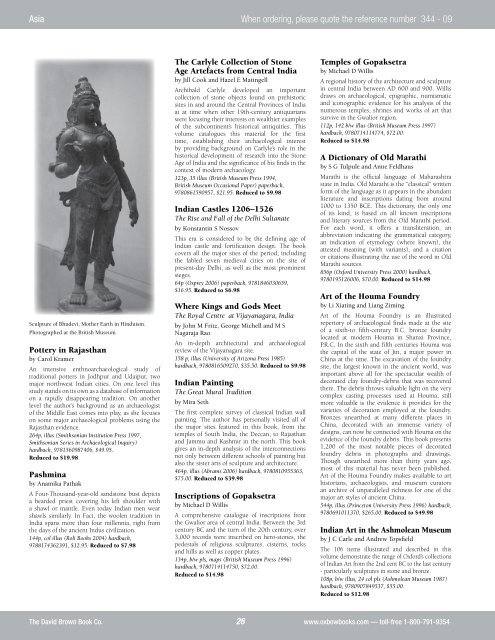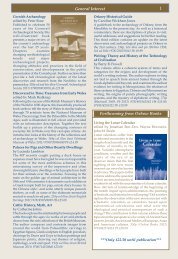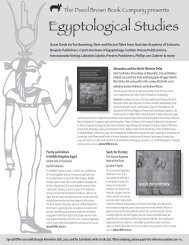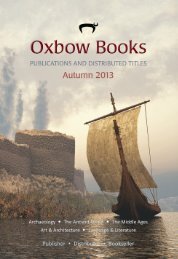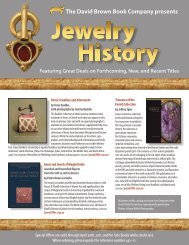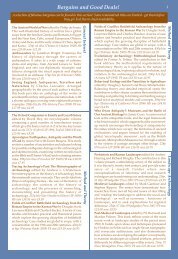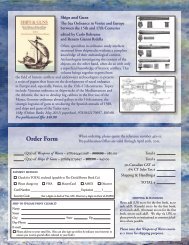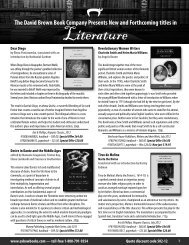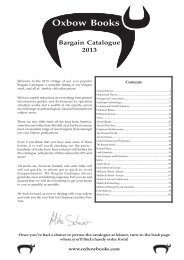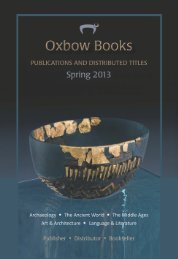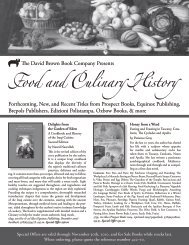AsiaWhen ordering, please quote the reference number 344 - 09Sculpture <strong>of</strong> Bhudevi, Mother Earth in Hinduism.Photographed at the British MuseumPottery in Rajasthanby Carol KramerAn intensive enthnoarchaeological study <strong>of</strong>traditional potters in Jodhpur and Udaipur, twomajor northwest Indian cities. On one level thisstudy stands on its own as a database <strong>of</strong> informationon a rapidly disappearing tradition. On anotherlevel the author’s background as an archaeologist<strong>of</strong> the Middle East comes into play, as she focuseson some major archaeological problems using theRajasthan evidence.264p, illus (Smithsonian Institution Press 1997,Smithsonian Series in Archaeological Inquiry)hardback, 9781560987406, $49.95.Reduced to $19.98Pashminaby Anamika PathakA Four-Thousand-year-old sandstone bust depictsa bearded priest covering his left shoulder witha shawl or mantle. Even today Indian men wearshawls similarly. In Fact, the woolen tradition inIndia spans more than four millennia, right fromthe days <strong>of</strong> the ancient Indus civilization.144p, col illus (Roli <strong>Books</strong> 2004) hardback,9788174362391, $12.95. Reduced to $7.98The Carlyle Collection <strong>of</strong> StoneAge Artefacts from Central Indiaby Jill Cook and Hazel E MatingellArchibald Carlyle developed an importantcollection <strong>of</strong> stone objects found on prehistoricsites in and around the Central Provinces <strong>of</strong> Indiaat at time when other 19th-century antiquarianswere focusing their interests on wealthier examples<strong>of</strong> the subcontinent’s historical antiquities. Thisvolume catalogues this material for the firsttime, establishing their archaeological interestby providing background on Carlyle’s role in thehistorical development <strong>of</strong> research into the StoneAge <strong>of</strong> India and the significance <strong>of</strong> his finds in thecontext <strong>of</strong> modern archaeology.123p, 35 illus (British Museum Press 1994,British Museum Occasional Paper) paperback,9780861590957, $21.95. Reduced to $9.98Indian Castles 1206–1526The Rise and Fall <strong>of</strong> the Delhi Sultanateby Konstantin S NossovThis era is considered to be the defining age <strong>of</strong>Indian castle and fortification design. The bookcovers all the major sites <strong>of</strong> the period, includingthe fabled seven medieval cities on the site <strong>of</strong>present-day Delhi, as well as the most prominentsieges.64p (Osprey 2006) paperback, 9781846030659,$16.95. Reduced to $6.98Where Kings and Gods MeetThe Royal Centre at Vijayanagara, Indiaby John M Fritz, George Michell and M SNagaraja RaoAn in-depth architectural and archaeologicalreview <strong>of</strong> the Vijayanagara site.158 p, illus (University <strong>of</strong> Arizona Press 1985)hardback, 9780816509270, $35.50. Reduced to $9.98Indian PaintingThe Great Mural Traditionby Mira SethThe first complete survey <strong>of</strong> classical Indian wallpainting. The author has personally visited all <strong>of</strong>the major sites featured in this book, from thetemples <strong>of</strong> South India, the Deccan, to Rajasthanand Jammu and Kashmir in the north. This bookgives an in-depth analysis <strong>of</strong> the interconnectionsnot only between different schools <strong>of</strong> painting butalso the sister arts <strong>of</strong> sculpture and architecture.464p, illus (Abrams 2006) hardback, 9780810955363,$75.00. Reduced to $39.98Inscriptions <strong>of</strong> Gopaksetraby Michael D WillisA comprehensive catalogue <strong>of</strong> inscriptions fromthe Gwalior area <strong>of</strong> central India. Between the 3rdcentury BC and the turn <strong>of</strong> the 20th century, over3,000 records were inscribed on hero-stones, thepedestals <strong>of</strong> religious sculptures, cisterns, rocksand hills as well as copper plates.134p, b/w pls, maps (British Museum Press 1996)hardback, 9780714114750, $72.00.Reduced to $14.98Temples <strong>of</strong> Gopaksetraby Michael D WillisA regional history <strong>of</strong> the architecture and sculpturein central India between AD 600 and 900. Willisdraws on archaeological, epigraphic, numismaticand iconographic evidence for his analysis <strong>of</strong> thenumerous temples, shrines and works <strong>of</strong> art thatsurvive in the Gwalior region.112p, 142 b/w illus (British Museum Press 1997)hardback, 9780714114774, $72.00.Reduced to $14.98A Dictionary <strong>of</strong> Old Marathiby S G Tulpule and Anne FeldhausMarathi is the <strong>of</strong>ficial language <strong>of</strong> Maharashtrastate in India. Old Marathi is the “classical” writtenform <strong>of</strong> the language as it appears in the abundantliterature and inscriptions dating from around1000 to 1350 BCE. This dictionary, the only one<strong>of</strong> its kind, is based on all known inscriptionsand literary sources from the Old Marathi period.For each word, it <strong>of</strong>fers a transliteration, anabbreviation indicating the grammatical category,an indication <strong>of</strong> etymology (where known), theattested meaning (with variants), and a citationor citations illustrating the use <strong>of</strong> the word in OldMarathi sources.856p (Oxford University Press 2000) hardback,9780195126006, $70.00. Reduced to $14.98Art <strong>of</strong> the Houma Foundryby Li Xiating and Liang ZimingArt <strong>of</strong> the Houma Foundry is an illustratedrepertory <strong>of</strong> archaeological finds made at the site<strong>of</strong> a sixth-to fifth-century B.C. bronze foundrylocated at modern Houma in Shanxi Province,P.R.C. In the sixth and fifth centuries Houma wasthe capital <strong>of</strong> the state <strong>of</strong> Jin, a major power inChina at the time. The excavation <strong>of</strong> the foundrysite, the largest known in the ancient world, wasimportant above all for the spectacular wealth <strong>of</strong>decorated clay foundry-debris that was recoveredthere. The debris throws valuable light on the verycomplex casting processes used at Houma; stillmore valuable is the evidence it provides for thevarieties <strong>of</strong> decoration employed at the foundry.Bronzes unearthed at many different places inChina, decorated with an immense variety <strong>of</strong>designs, can now be connected with Houma on theevidence <strong>of</strong> the foundry debris. This book presents1,200 <strong>of</strong> the most notable pieces <strong>of</strong> decoratedfoundry debris in photographs and drawings.Though unearthed more than thirty years ago,most <strong>of</strong> this material has never been published.Art <strong>of</strong> the Houma Foundry makes available to arthistorians, archaeologists, and museum curatorsan archive <strong>of</strong> unparalleled richness for one <strong>of</strong> themajor art styles <strong>of</strong> ancient China.544p, illus (Princeton University Press 1996) hardback,9780691011370, $265.00. Reduced to $49.98Indian Art in the Ashmolean Museumby J C Carle and Andrew TopsfieldThe 106 items illustrated and described in thisvolume demonstrate the range <strong>of</strong> Oxford’s collections<strong>of</strong> Indian Art from the 2nd cent BC to the last century- particularly sculptures in stone and bronze.108p, b/w illus, 24 col pls (Ashmolean Museum 1987)hardback, 9780907849537, $55.00.Reduced to $12.98The David Brown Book Co. 26 www.oxbowbooks.com — toll-free 1-800-791-9354
When ordering, please quote the reference number 344 - 09AsiaGift <strong>of</strong> the ConquerorsHand Papermaking in Indiaby Alexandra SoteriouComprehensive and detailed, this book traces thenearly thousand year history <strong>of</strong> hand papermakingin India, from the ancient sites in Gilgit and theHimalayas, through heartland Mathura, Agra,Daulatabad to the western sites in Rajasthan andGujarat, to Pondicherry on the Bay <strong>of</strong> Bengal.Illustrated with numerous color photographs, thestory is revealed through India’s visual art.248p, 218 col illus (Mapin 1998) hardback,9780944142561, $125.00. Reduced to $59.98Feet and Footwear in IndianCultureby Jutta Jain-NeubauerIllustrates the religious and erotic significance<strong>of</strong> feet and footwear through the richness anddiversity <strong>of</strong> ancient footwear.176p (Mapin 2006) hardback, 9781890206208,$55.00. Reduced to $29.98Silk Brocadesby Yashodhara AgrawalA fascinating history <strong>of</strong> brocades from their originin ancient China and India, their spread to othercountries and the evolution <strong>of</strong> design and pattern.144p, col illus (Roli <strong>Books</strong> 2004) hardback,9788174362582, $12.95. Reduced to $7.98Monks and MerchantsSilk Road Treasures From Chinaby Judith A LernerThe northwest region <strong>of</strong> China comprising themodern provinces <strong>of</strong> Gansu and Ningxia formed anatural geographical corridor to China’s heartlandfor foreign traders and missionaries traveling theSilk Road from regions as far west and India, Rome,and Byzantium. Monks and Merchants is the firstbook to focus on this region and the crucial role itplayed in the transformation <strong>of</strong> Chinese civilizationfrom the fourth through the seventh century.352p (Abrams 2001) hardback, 9780810934788,$65.00. Reduced to $29.98Bronze Vessels <strong>of</strong> Ancient Chinain the Avery Brundage Collectionby René-Yvon d’ArgenceA well-illustrated catalogue <strong>of</strong> Chinese bronzeworkfrom the incomparable Asian Art Museum <strong>of</strong> SanFrancisco.144p, illus (Asian Art Museum 1977) paperback,9780295966489, $19.95. Reduced to $9.98Fire and WaterThe Art <strong>of</strong> Incendiary Aquatic Warfare in Chinaby Ralph D SawyerAn expert in Chinese Warfare, best-selling authorRalph Sawyer, <strong>of</strong>fers a compelling account <strong>of</strong> thedevelopment <strong>of</strong> incendiary and aquatic warfaretactics in ancient China as pivotal elements inturning the tides <strong>of</strong> battle.352p (Westview Press 2003) hardback,9780813340654, $26.00. Reduced to $9.98The Search for Ancient Chinaby Corinne Debaine-FrancfortThis pocketbook provides a well illustratedintroduction to the history and culture <strong>of</strong> Chinafrom the Chinese Neolithic until the Han Dynasty(206 BC – AD 220).160p (Thames and Hudson 1999, New Horizons)paperback, 9780500300954, $12.95.Reduced to $5.98A Journey into China’s AntiquityVolume 1: Palaeolithic Age –Spring Autumn Periodby the National Museum <strong>of</strong> Chinese HistoryCompiled and written by experts from the NationalMuseum <strong>of</strong> Chinese History, Beijing, which housesthe most recent and important archaeologicalartifacts, this series <strong>of</strong> 4 volumes takes the readerthrough the development <strong>of</strong> Chinese culturethrough its rich collection <strong>of</strong> artifacts. Well-editedand illustrated with excellent photographs, theseries aims to give a faithful and reliable guide toChinese cultural history. Featuring some <strong>of</strong> themost spectacular items ever discovered, it tellsa story through a well-balanced presentation <strong>of</strong>excellent text, material and illustrations.This first volume covers the period from China’searliest ape-man (Homo erectus), YuanmouMan, who lived 1.7 million years ago to the lateSpring and Autumn Period. It details early humansettlement in China, especially the Neolithic age,and reveals the first dynastic ages <strong>of</strong> Xia and Shang,the development <strong>of</strong> bronze and iron usage, andthe turbulance in the Spring and Autumn periodthat gave rise to the most important Chinesephilosophers and military strategist such as Kongzi(Confucius) and Sunzi.271p, 274 col illus (Art Media Resources 1997)hardback, 9787505404762, $80.00.Reduced to $39.98A Journey into China’s AntiquityVolume 2: Warring States Period – Northernand Southern Dynastiesby the National Museum <strong>of</strong> Chinese HistoryThis second volume covers the Warring Statesperiod (4th century BC) to the Northern andSouthern Dynasties (6th century BC). Herewe learn about the Warring States period, itsaccomplishment in fostering new ideas and schools<strong>of</strong> thoughts, the unification <strong>of</strong> China, socially andeconomically, by the First Emperor <strong>of</strong> Qin, thenits decline and the rise and splendor <strong>of</strong> the Handynasty, and later came the first major contactbetween China and foreigners through CentralAsia and the arrival <strong>of</strong> Buddhism.271p, 274 col illus (Art Media Resources 1997)hardback, 9787505404830, $80.00. Reduced to$39.98A Journey into China’s AntiquityVolume 3: Sui & Tang Dynasties,Five Dynasties & Ten Kingdom Period,Northern & Southern Song Dynastiesby the National Museum <strong>of</strong> Chinese HistoryCovering the period from the end <strong>of</strong> the sixthcentury to the late 13th century, this volumewitnesses the zenith <strong>of</strong> international contact inthe Tang dynasty as manifested in all art forms:ceramics, painting, sculpture, and literature. AfterTang declined and the country fragmented, theSong dynasty rose and became one <strong>of</strong> the mostvital dynasties famous for its finest ceramics andpaintings.323p, 321 col illus (Art Media Resources 1998)hardback, 9787505405073, $80.00. Reduced to$39.98A Journey into China’s AntiquityVolume 4: Yuan Dynasty – Qing Dynastyby the National Museum <strong>of</strong> Chinese HistoryThis volume covers the period from the Yuan tothe Qing dynasty. In this volume we witness theMongolian achievements, the Manchu conquest,and the rise <strong>of</strong> foreign power that saw the end<strong>of</strong> Chinese dynastic empires. Illustrated withexquisite paintings and artifacts, including tributesfrom other countries to the Qing court.302p, 274 col illus (Art Media Resources 1998)hardback, 9787505405141, $80.00.Reduced to $39.98ChinaDawn <strong>of</strong> a Golden Age, 200–750 ADby James C WattThis book is the first comprehensive survey <strong>of</strong>Chinese art during this complex era. Lavishlyillustrated and produced, the volume presentsmore than three hundred recent archaeologicalfinds: including gold artifacts made by thenomadic peoples from Mongolia, luxury articles<strong>of</strong> glass and precious metals from Western andCentral Asia, early Chinese Buddhist sculptures,and spectacular works in every medium fromthe Tang period. Essays by distinguished scholarsprovide a historical background, discuss thevarious media, and trace the changes in art stylesover a period that saw a radical modification <strong>of</strong>Chinese civilization.416p, illus (Metropolitan Museum <strong>of</strong> Art 2004)paperback, 9780300104875, $75.00.Reduced to $14.98The Lost <strong>Books</strong> <strong>of</strong> Medieval Chinaby Glen DudbridgeThese lectures discuss the dynamics <strong>of</strong> lossand survival; the role <strong>of</strong> the imperial state inmanipulating book culture through classificationand selective preservation; the significance <strong>of</strong>lost books as an index <strong>of</strong> superseded knowledgeand values. An analysis <strong>of</strong> two specific casesdemonstrates the insights to be gained throughtextual reconstruction, and the inadequacies <strong>of</strong>standard classification in times past and present.Medieval Chinese literature emerges as a richer,more problematic, less docile body <strong>of</strong> work thanthe orthodoxies <strong>of</strong> the last millennium would wish.80p (The British Library 2000) paperback,9780712346887, $32.00. Reduced to $9.98The David Brown Book Co. 27 www.oxbowbooks.com — toll-free 1-800-791-9354
- Page 2 and 3: Of General InterestWhen ordering, p
- Page 4 and 5: Discovery & ExplorationWhen orderin
- Page 6 and 7: AfricaWhen ordering, please quote t
- Page 8 and 9: AfricaWhen ordering, please quote t
- Page 10 and 11: The AmericasWhen ordering, please q
- Page 12 and 13: The AmericasWhen ordering, please q
- Page 14 and 15: The AmericasWhen ordering, please q
- Page 16 and 17: The AmericasWhen ordering, please q
- Page 18 and 19: The AmericasWhen ordering, please q
- Page 20 and 21: The AmericasWhen ordering, please q
- Page 22 and 23: The AmericasWhen ordering, please q
- Page 24 and 25: The AmericasWhen ordering, please q
- Page 28 and 29: AsiaWhen ordering, please quote the
- Page 30 and 31: Asia ‐‐ Oceania and the Pacific
- Page 32: Convenient Ways to Order:• Call u


